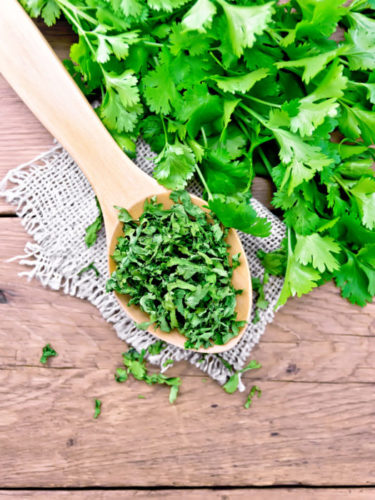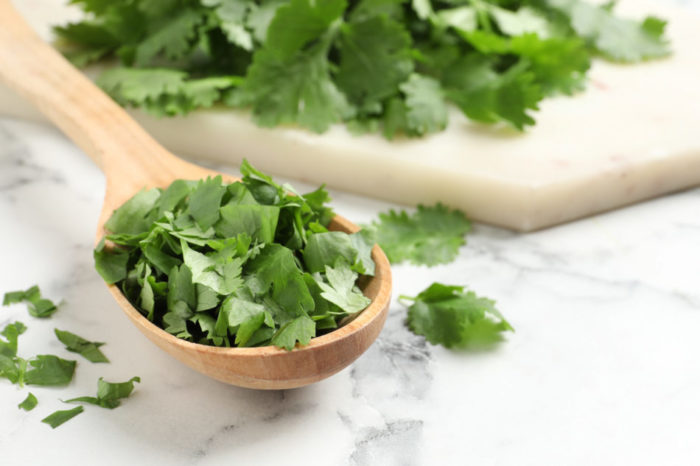Use it dried or fresh, cilantro is a key element in several recipes across global cuisines. It’s popular with several cuisines, especially Mexican, Indian, Asian, and Middle Eastern cuisines. Since the herb is used both dried and fresh, does it mean they both have similar uses? Let’s take a closer look at what sets dried cilantro vs fresh apart.
It is the same plant, in a rather similar form, so it would be natural to expect a small difference. However, these small changes can go a long way in the culinary world. Let’s see how it all shapes up.

Dried Cilantro vs Fresh Cilantro – All You Need To Know
On Cilantro And Coriander
There is often a confusion about cilantro and coriander and what sets them apart. Both these terms generally refer to the same plant (Coriandrum sativum) but the definitions can vary by region.
In the USA, cilantro represents the fresh, green leaves of the plant. Many people also extend it to include all green parts (including stem) of the plant. In this case, the seeds of the plant are called coriander.
For most of the world, it is the coriander plant. The leaves are coriander leaves and seeds are coriander seeds. In fact, cilantro is the Spanish word for coriander. As the use of coriander leaves in Mexican cuisine reached the USA, the word cilantro became synonymous with coriander leaves. The seeds, however, stayed on as coriander seeds.

The Taste And Characteristics Of Dried Cilantro and Fresh
The fresh cilantro herb is best regarded for its strong taste. It has a strong citrusy flavor with some peppery notes. The strong flavor and aroma are the reason why the use of this herb is so popular in global cuisine. However, some people also find cilantro to taste somewhat soapy, and would prefer not to have it in their food.
Dried cilantro has a similar flavor, though milder. After all, dried cilantro is simply fresh cilantro leaves that have been dried. It has a longer shelf-life than fresh cilantro, but its culinary uses are somewhat different.
There’s an interesting property for dried cilantro. Many herbs, as they dry, tend to have a stronger flavor as compared to the fresh herb. Not cilantro though. Dried cilantro has a weak citrusy flavor with hints of that peppery touch. It can still feel soapy to some, but the flavor is quite mild anyway.
So, the change in flavor and change in texture due to the drying of the leaves makes dried cilantro fairly different from fresh cilantro. In many culinary uses, both of these are different ingredients with separate uses, rather than being the same.
FAQ
Can You Substitute Dried Cilantro For Fresh?
While fresh cilantro and dried cilantro share a similar flavor, they’re not interchangeable. Dried cilantro is significantly milder than fresh cilantro and also takes on a different texture. Adding dried cilantro in place of fresh cilantro won’t bring out the same flavor and aroma.
Overusing dried cilantro to make up for the milder flavor is very likely to negatively affect the taste and texture of the recipe rather than contributing to it. Therefore, dried cilantro isn’t a good substitute for fresh cilantro.
If you need a replacement for cilantro, it’s better to look at similarly fresh and green herbs. Alternatively, you could consider skipping it altogether. Replacing fresh cilantro with dried isn’t likely to yield good results.
How Much Dried Cilantro Equals Fresh?
Generally speaking, a full cup of fresh cilantro would result in a quarter to one-third cup of dried cilantro. A rule of thumb for fresh to dried herbs is that when replacing fresh herbs in a recipe, you can use the same dried herb in a one-third amount.
However, for cilantro, this relation is purely academic. Dried cilantro doesn’t equal fresh cilantro and shouldn’t be used as a replacement or equivalence of the fresh herb.
How To Use Dried Cilantro?
Dried cilantro has a fairly mild flavor compared to fresh cilantro. Also, it isn’t a suitable replacement for the fresh herb. So, what is the purpose of dried cilantro and where can we use it?
To be clear, dried cilantro has rather limited applications, so some sort of culinary knowledge and cooking experience is good to steer you in the right direction. Generally, dried cilantro is a good companion to saucy recipes. You can use it for marinades, soups, stews, and beans.
For many of its applications, you’ll likely have to add a significant amount of dried cilantro to get a good flavor. Remember not to go overboard adding this ingredient as it can affect the texture and mouthfeel of a recipe. For example, dried cilantro is useful for marinades, but its overuse can give the meat a rough and unpleasant texture.
Note that the use of dried herbs and fresh herbs in a recipe usually varies. Fresh herbs usually get added towards the end of cooking to add more flavor and zest to the recipe. Mostly, fresh herbs can’t take long cooking periods. In the opposite direction, dried herbs should be added to recipes earlier so they can get a good touch of flavor for the dish.
What’s A Good Substitute For Cilantro?
If you want a substitute for cilantro, consider herbs that are similarly fresh and flavorful. It’s not a good idea to use dried cilantro as a substitute, or similarly, other dried herbs. Consider other garnishes and fresh green leaves as better options for substitution.
Some of the best choices to substitute cilantro are:
- Italian parsley
- Parsley
- Mint
- Thai basil
- Rau Ram
- Tarragon
- Dill
- Garam masala
- Papalo
The Bottom Line
One would expect there to be little to no difference in dried cilantro vs fresh comparison. However, this combo takes a departure from how most herbs behave. Dried cilantro has a flavor that is very mild as compared to fresh cilantro.
This change also means that its culinary uses are greatly limited and dried cilantro can’t be a viable replacement for fresh cilantro in most recipes. Though variations of the same herb, dried and fresh cilantro shouldn’t be used interchangeably.